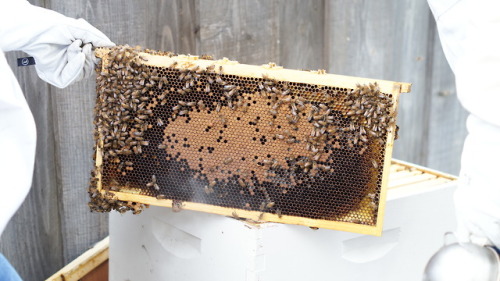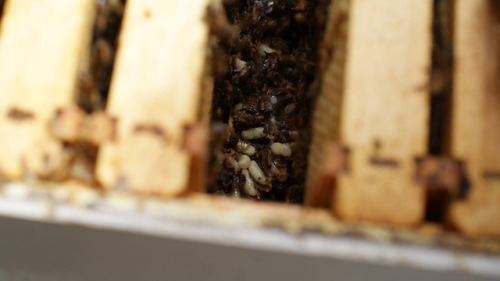#apiarist
I forget when we found the first swarm of bees, maybe two weeks ago? Anyway, it was a small swarm and a beekeeper came over and scooped them into a hive. Then, yesterday evening, we found another much larger swarm. They were huddled in a tree near the road. A second beekeeper (brother-in-law of the first) came over right at dusk. He placed the hive under the mass of bees and then gently shook the tree. They plopped into the box, and those who were left out filed neatly and quickly inside after their queen.
At this point, who knows how many bees are still in the wall of the house. And there were three queens? Or maybe the workers made themselves a new queen very quickly after their first swarm got disrupted by cold weather. If we are REALLY lucky, maybe this is all of them, and the wall of the house is beeless, now.
Anyhoo, I very, very much wanted to walk over and gently put my hand in among the bees. I didn’t, but I wanted to.
Post link
My bees swarmed today. That means they’re doing well enough to split! Half took off and the other half will stay with me.
My dad was giving me a hard time when we did a hive check for taking so many photographs while we looked at the brood frames. Well, the other day I was out observing the hive and I came across a few feet of yard that was completely covered in dead and dying bees. The bee graveyard. You couldn’t even see the dirt of the ground, it was completely hidden by bee bodies. I collected a large drone that was scrambling around. At first glance, he looked normal, healthy. No tattered wings even. Once I scooped him up and took some photos of him, I saw it. A little brown dot, the size of a pinhead, on his fuzzy thorax. Varroa mites. AKA the bee version of ticks. They say when you see one, there’s a lot more where that came from. Then I re-examined the photos I’d taken the week before during the hive inspection. While I hadn’t noticed it the first time looking at the photos, this time I could pick out a mite here and a mite there. Then, the disfigured wings of a bee, indicating it had Deformed Wing Virus. Not good.
So now we are working on helping the bees rid themselves of the mites before the mite population grows and overwhelms the bees and we see a colony collapse. Natural treatment includes placing a mite catcher at the bottom of the hive (with a screen only the mites can fit & fall through, and sticky paper underneath to trap them) and dusting the bees themselves with a thin coat of powdered sugar which encourages them to groom themselves and then hopefully groom off the mites, dropping them down into the trap below.
I’ll post updates, but please wish our bees some extra strength and vitality as they fight off their mites! And taking photos during your hive inspections is a great way to document the hive health and provides you with clear references of your bees without having a time-limit or needing to worry about stressing them (except for that initial inspection), and then you can always go back and look for things you may have missed upon the live-inspection.
Photo descriptions:
1. A brood frame
2. A couple mites on some of the larvae
3. In the middle right you can see a drone with a mite on his thorax
4. On the far left and also in the center there are two bees with Deformed Wing Virus.
@celebrateasimplelife no, we didn’t lose them! They made a full recovery. And we did not treat them with Oxalic Acid (poison) as many keepers will recommend for mites.. we treated every few days for about a month with sprinkling them with powdered sugar which encourages them to clean themselves off and groom one another (and pull mites off). We also added a grate and sticky sheet to the bottom board so as mites fell off they would be trapped and more easily cleaned out. And finally we made sure the hive could retain its high internal temps by switching back to the “winter” top instead of the “summer” top that lets a lot more air flow through and is more cooling because the mites don’t survive in high temps (but bees do - just not too hot - but they are good at regulating and will put workers outside the entrance to fan in air if they need to)
Post link






